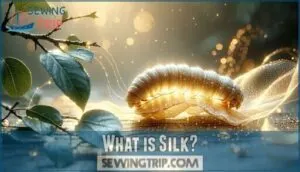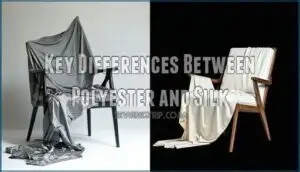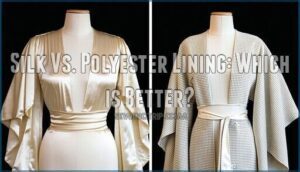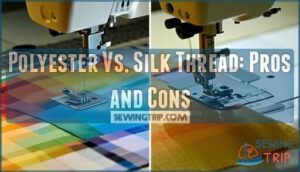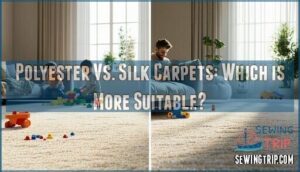This site is supported by our readers. We may earn a commission, at no cost to you, if you purchase through links.
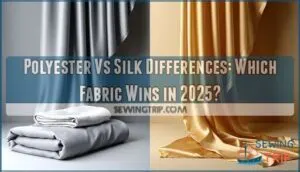
Polyester’s a synthetic fiber made from petroleum that’s tough, wrinkle-resistant, and machine-washable – perfect for your busy lifestyle.
Silk’s a natural protein fiber from silkworms that feels like luxury against your skin, breathes beautifully, but wrinkles if you look at it wrong and needs babying with hand-washing.
Polyester costs pennies compared to silk’s premium price tag, but silk wins hands-down for comfort and temperature regulation.
Your choice boils down to practicality versus indulgence – though there’s more to this fabric face-off than meets the eye.
Table Of Contents
- Key Takeaways
- What is Polyester?
- What is Silk?
- Key Differences Between Polyester and Silk
- How to Tell The Difference Between Polyester and Silk
- Is Polyester Better Than Silk?
- Choosing Between Polyester and Silk Pillowcases
- Polyester Vs. Silk for Clothing and Bedding
- Silk Vs. Polyester Lining: Which is Better?
- Polyester Vs. Silk Thread: Pros and Cons
- Polyester Vs. Silk Carpets: Which is More Suitable?
- Frequently Asked Questions (FAQs)
- Conclusion
Key Takeaways
- You’ll pay drastically different prices – polyester costs pennies compared to silk’s premium price tag, making it up to 10 times more budget-friendly for everyday use
- Your maintenance routine depends on fabric choice – you can machine wash polyester without worry, but silk demands gentle hand washing or dry cleaning to prevent damage
- Comfort levels vary significantly – silk naturally regulates temperature and feels luxurious against your skin, while polyester tends to trap heat and has a rougher synthetic feel
- Durability expectations differ completely – polyester resists wrinkles and lasts years with heavy use, but silk requires careful handling and shows wear more easily despite lasting decades when properly maintained
What is Polyester?
When you’re shopping for fabric, polyester stands out as the workhorse of synthetic fibers.
This petroleum-based material undergoes polymerization during polyester production, creating durable threads that resist wrinkles and fading.
Chemical magic transforms crude oil into wrinkle-proof synthetic fibers that outlast nature’s own creations
Unlike natural fabric types, polyester material offers impressive strength at budget-friendly material costs.
You’ll find polyester fabrics everywhere—from workout gear to home furnishings.
While it lacks silk’s luxurious feel, polyester fabric characteristics include easy care and longevity.
In textile science, it’s considered the reliable friend who never lets you down, even if they’re not the flashiest at the party.
What is Silk?
From ancient China’s imperial courts to today’s luxury markets, silk stands as nature’s most sophisticated textile achievement.
This natural protein fiber emerges through sericulture process, where silkworms spin protective cocoons from their saliva.
Silk production begins when Bombyx mori larvae feast on mulberry leaves, eventually creating cocoons that craftspeople carefully unwind into continuous threads.
These silk fibers possess unique triangular structures that create silk fabric’s characteristic shimmer and temperature-regulating properties.
With over 5,000 years of silk history, this natural fiber remains unmatched for breathability and moisture-wicking capabilities, making silk vs polyester comparisons inevitable in today’s textile landscape.
Key Differences Between Polyester and Silk
You’ll notice striking differences between these two fabrics that go far beyond just price.
While polyester brings synthetic durability and easy care to your wardrobe, silk offers natural luxury with unique properties that can’t be replicated.
Fiber Composition
Understanding fiber composition helps you make informed choices between these two materials.
The fundamental difference lies in their origins and molecular structure.
Natural Fibers vs Synthetic Materials:
- Silk comes from silkworms through sericulture, creating protein-based fibers with complex amino acid chains
- Polyester originates from petroleum-based chemicals via polymerization, forming uniform polymer strands
This fiber structure affects everything from breathability to durability.
Silk’s natural protein composition makes it hypoallergenic and temperature-regulating, while polyester’s synthetic polymer chains provide wrinkle resistance and strength.
Material science shows these compositional differences directly impact performance metrics you’ll experience daily.
The choice between silk and polyester often depends on understanding silk benefits for specific applications.
Texture and Feel
The texture difference between these fabrics feels like night and day when you touch them.
Silk’s smooth texture delivers a gentle feel that’s naturally cool and breathable, while polyester fabric characteristics include a slightly rougher, less luxurious sensation.
This softness comparison reveals how natural vs synthetic fibers create different experiences.
Silk’s fabric drape flows beautifully thanks to its silk fabric properties, whereas polyester’s breathability properties can’t match silk’s superior temperature regulation and comfort.
The difference in breathability properties is notable, as silk provides a naturally cool and breathable experience.
Wrinkling and Creasing
Polyester fabric characteristics shine when you’re battling fabric wrinkles – this synthetic superstar boasts impressive crease resistance that’ll save your sanity on busy mornings.
Meanwhile, silk fabric properties tell a different story; this natural beauty wrinkles faster than you can say "dry cleaner."
Here’s your fabric comparison and analysis breakdown:
- Polyester: Superior wrinkle resistance means less ironing and steaming methods needed
- Silk: Requires gentle fabric relaxation techniques and professional care for best results
- Natural vs synthetic fibers: Polyester’s chemical structure creates built-in crease resistance, while silk’s protein fibers naturally fold
Smart ironing tips can help both fabrics, but polyester clearly wins the low-maintenance game in this silk vs polyester comparison.
Maintenance and Care
Unlike wrinkle-prone silk, both fabrics require different fabric care approaches to maintain their quality and appearance.
Washing Instructions
You can machine wash polyester using cold water and gentle cycles, while silk demands hand washing or delicate machine cycles with mesh bags. Never use bleach on silk—it’ll break down fibers and cause color loss. Polyester handles standard detergents better, but both fabrics benefit from mild cleaning products.
Stain Removal and Fabric Softening
Oil-based stains cling to polyester’s synthetic fibers, requiring dish soap pretreatment. Silk needs gentle blotting with specialized cleaners—rubbing damages delicate fibers. Act quickly on both fabrics for best results.
Dry Cleaning and Ironing Tips
Polyester tolerates low-heat tumble drying, while silk requires air-drying away from sunlight. For ironing tips: use low heat on polyester and silk’s reverse side while slightly damp.
Storage Methods
- Store silk on padded hangers in breathable cotton bags to prevent creasing and yellowing
Proper fabric maintenance tips extend both materials’ lifespan substantially. This durability comparison shows polyester’s resilience versus silk’s need for careful handling in fabric care and maintenance routines. Following proper silk care tips is essential for maintaining the quality of silk garments.
How to Tell The Difference Between Polyester and Silk
You can easily distinguish between polyester and silk using three reliable methods that work every time.
Start with visual inspection to check the sheen, then feel the texture, and if you’re still unsure, try the burn test for definitive identification.
Visual Inspection
Looking at fabrics side-by-side reveals telling differences in their appearance.
Check the shine comparison between these materials—silk displays a subtle, shifting luster while polyester shows consistent white reflection.
The weave pattern also differs noticeably.
Here’s what sparks immediate recognition:
- Fabric appearance that screams luxury versus mass production
- Color variation that dances with light versus static uniformity
- Texture check revealing natural imperfections versus artificial perfection
Natural vs synthetic fibers create distinctly different visual signatures.
Silk’s triangular fiber structure produces that coveted shimmer, while polyester’s uniform construction yields predictable shine.
During fabric comparison and analysis, notice how silk fabric properties include visible patterns on both sides, unlike polyester fabric characteristics showing boring symmetry.
Tactile Sensations
The tactile experience reveals each fabric’s true identity through your fingertips.
When conducting a sensory experience for fabric feel assessment, you’ll notice distinct differences in their tactile properties.
Key texture analysis indicators:
- Silk fabric properties: Smooth, cool touch with luxurious softness that feels naturally warm against skin
- Polyester fabric characteristics: Rougher surface with synthetic feel, often described as slippery or stiff
This softness comparison between natural vs synthetic fibers helps identify authenticity.
Your silk vs polyester comparison becomes clearer through hands-on fabric comparison and analysis, making tactile testing essential for accurate identification.
Understanding the silk benefits can further enhance the distinction between these fabrics.
Burn Test
Sometimes the simplest tests reveal the biggest truths about fabric composition.
The burn test offers a reliable method to distinguish between silk fabric and polyester fabric when visual inspection isn’t enough. You’ll need just a small sample and a lighter to perform this flame resistance analysis.
| Test Aspect | Polyester Fabric | Silk Fabric |
|---|---|---|
| Fiber Melting | Melts quickly, forms hard beads | Burns steadily, doesn’t melt |
| Smoke Emission | Black smoke with chemical odor | White smoke, hair-like smell |
| Heat Damage | Shrinks away from flame | Burns toward flame source |
| Ash Residue | Hard, crushable beads | Soft, powdery ash |
Natural fibers like silk burn differently than synthetic fibers due to their protein structure. Polyester’s petroleum base creates that distinctive plastic smell, while silk’s protein composition produces an odor similar to burning hair.
This simple test helps you avoid synthetic imposters masquerading as luxury silk.
Is Polyester Better Than Silk?
Now that you know how to tell these fabrics apart, the big question remains: which one’s actually better? The answer isn’t straightforward—it depends on what you value most.
Here’s how polyester vs silk comparison breaks down in key areas:
- Cost Comparison: Polyester costs up to 10 times less than silk fabric, making it budget-friendly for everyday use
- Fabric Durability: Polyester wins hands-down with wrinkle resistance and machine-washable convenience
- Comfort Factor: Silk fabric delivers superior breathability and temperature regulation that polyester can’t match
- Eco Impact: Silk biodegrades naturally while polyester sheds microplastics and persists for centuries
From a Textile Science perspective, each fabric excels in different areas. Polyester dominates Fashion Trends for activewear due to its resilience, while silk and polyester differences become clear in luxury applications where comfort matters most. The natural silk insulating properties of silk make it a preferred choice for cold weather clothing.
Choosing Between Polyester and Silk Pillowcases
When you’re choosing a pillowcase, the fabric makes all the difference in your sleep quality and comfort.
Silk offers temperature regulation and skin benefits, while polyester provides durability and easy care at a fraction of the cost, with durability being a key factor.
Silk Vs Polyester Qualities
Choosing between silk and polyester pillowcases means weighing key qualities that affect your sleep experience.
Silk’s natural fiber benefits include superior breathability factors and textile softness, creating a cooler, gentler surface that’s kinder to hair and skin.
However, material costs run substantially higher than polyester alternatives.
Polyester offers impressive fabric durability and wrinkle resistance at budget-friendly prices, though it lacks silk’s temperature regulation.
The eco impact differs dramatically—silk biodegrades naturally while polyester contributes to microplastic pollution, making this silk vs polyester comparison about balancing comfort, cost, and environmental responsibility.
For the best results, consider a high quality silk pillowcase option to enhance your sleeping experience.
Care and Maintenance Differences
Polyester’s machine-washable nature makes fabric care a breeze, while silk demands gentle hand washing with pH-neutral detergents.
For stain removal, polyester repels most spills effectively, but silk absorbs stains quickly, often requiring dry cleaning.
Wrinkle prevention isn’t needed with polyester’s natural resistance, unlike silk’s creasing tendency.
Fabric storage differs too—polyester tolerates compression, while silk needs breathable fabric storage.
Understanding proper fabric care products is essential for maintaining the quality of both fabrics, and following the right techniques.
Choosing The Right Fabric
Your budget and lifestyle needs should guide your fabric selection.
If you’re investing in quality sleep and have the budget, silk fabric delivers superior temperature regulation and hair benefits that justify material costs.
For budget-conscious shoppers, high-quality polyester fabric offers decent comfort at lower textile quality expectations.
Consider sustainable choices too – silk’s biodegradable nature beats polyester’s environmental impact.
Fashion trends currently favor natural materials, making silk and polyester differences more pronounced in 2025’s eco-conscious market.
Polyester Vs. Silk for Clothing and Bedding
Understanding your fabric choice impacts everything from your morning comfort to evening style.
Let’s break down the polyester vs silk debate with real performance metrics.
| Factor | Polyester Fabric | Silk Fabric |
|---|---|---|
| Fabric Durability | High resistance to wear, lasts years | Delicate, requires gentle handling |
| Color Fastness | Excellent retention, won’t fade | Moderate, may fade with sun exposure |
| Breathability | Low, traps heat and moisture | Excellent, regulates temperature naturally |
| Eco Impact | Non-biodegradable, sheds microplastics | Biodegradable, sustainable production |
| Cost Comparison | Budget-friendly, $5-18 per yard | Premium pricing, $35-60+ per yard |
Your polyester clothing bounces back from machine washing while silk demands careful attention.
This Silk Vs Polyester Comparison shows polyester wins on convenience, but silk delivers unmatched luxury and skin benefits for those willing to invest in quality comfort.
The natural protein fiber in silk provides superior temperature regulation benefits that make it ideal for sensitive skin.
Silk Vs. Polyester Lining: Which is Better?
When selecting between lining materials for your garments, you’ll find stark contrasts in performance metrics.
Silk fabric offers superior breathability and hypoallergenic properties, while polyester fabric delivers exceptional durability and wrinkle resistance.
This fabric comparison reveals how textile science impacts garment construction.
| Feature | Silk Lining | Polyester Lining |
|---|---|---|
| Breathability | Excellent moisture-wicking | Poor heat retention |
| Durability | Moderate, needs gentle care | Excellent, machine washable |
| Cost | Premium pricing | Budget-friendly |
| Texture | Smooth, luxurious drape | Stiffer, synthetic feel |
| Maintenance | Dry cleaning required | Easy machine washing |
Your choice depends on priorities: silk excels in comfort and elegance for luxury pieces, while polyester dominates practical applications through robust fabric durability and simplified sewing techniques.
Understanding the best lining options is essential for achieving the desired garment performance and aesthetic.
Polyester Vs. Silk Thread: Pros and Cons
Threading your way through sewing projects? Your choice between polyester and silk thread can make or break your fabric creation.
While silk brings natural luxury to your stitching, polyester delivers industrial-strength performance that won’t quit.
| Aspect | Polyester Thread | Silk Thread |
|---|---|---|
| Thread Strength | High tensile strength, withstands 1,500 stitches/min | Fine composition, up to 0.5 GPa strength |
| Durability | Resists stretching, tearing, frequent washing | Susceptible to chemicals, snagging, staining |
| Best Use | Heavy-duty, activewear, mass production | Luxury garments, embroidery, heirloom pieces |
Polyester vs silk thread choice depends on your project’s demands.
Polyester’s 26% stretch makes it perfect for fabric blends requiring flexibility.
Silk thread excels in weaving techniques where natural fibers shine, offering smooth hand-stitching without tangling.
For sewing tips: choose polyester for everyday durability, silk for special occasions requiring that premium finish.
Polyester Vs. Silk Carpets: Which is More Suitable?
Carpet choice affects your entire room’s vibe and performance. While thread selection matters for garments, flooring decisions impact daily comfort and long-term investment.
Performance Comparison:
| Factor | Polyester | Silk |
|---|---|---|
| Carpet Durability | 5-15 years | 30+ years |
| Stain Resistance | Excellent | Moderate |
| Price Range | $0.50-$6/sq ft | $15+/sq ft |
Polyester carpets excel in high-traffic areas with superior stain resistance and easy floor maintenance. They’re perfect for families needing practical carpet styles that handle spills without breaking budgets.
Silk fabric carpets offer unmatched luxury with superior room acoustics and longevity. These textile differences shine in formal spaces where foot traffic stays minimal.
Your material comparison boils down to lifestyle needs. Choose polyester for everyday durability or silk for timeless elegance. Both fabric types serve distinct purposes in modern homes. When considering carpet options, understanding polyester carpet characteristics is essential for making an informed decision.
Frequently Asked Questions (FAQs)
Can silk and polyester be blended together to create a fabric?
Approximately 55% of global apparel uses synthetic fibers, with polyester dominating the market.
Yes, you can absolutely blend silk and polyester together, creating fabrics that combine silk’s luxurious feel with polyester’s durability and affordability.
Are there any environmental concerns associated with the production of silk and polyester?
You’ll face different environmental challenges with both fabrics. Silk production requires extensive water usage and chemical processing, while polyester creates microplastic pollution and relies on petroleum-based resources that aren’t biodegradable.
Can silk and polyester fabrics be dyed in the same way?
Silk and polyester require different dye processes.
You’ll find silk absorbs acid dyes beautifully due to its protein structure.
While polyester needs disperse dyes and high heat since it’s synthetic and won’t accept traditional dyes.
Are there any specific care instructions for polyester and silk fabrics?
You’ll want to treat these fabrics differently – silk needs gentle hand washing or dry cleaning, while polyester handles machine washing well.
Silk requires cool water and special detergents, but polyester’s practically bulletproof with regular care.
Can you iron silk and polyester fabrics in the same way?
No, you can’t iron these fabrics the same way.
Silk needs low heat and a pressing cloth to prevent damage, while polyester handles medium heat directly.
Different fibers demand different care approaches.
Can polyester cause allergic reactions or skin irritation?
Polyester can trigger skin irritation in sensitive individuals. You’ll likely experience itchiness, rashes, or discomfort because synthetic fibers trap heat and moisture, creating conditions that irritate skin naturally.
Which fabric lasts longer with regular use?
Durability hinges on care, usage patterns, and fabric quality. You’ll find polyester outlasts silk with regular use—it’s wrinkle-resistant, fade-resistant, and handles frequent washing better than silk’s delicate fibers.
Does polyester or silk stain more easily?
Silk stains more easily than polyester because it’s a delicate natural fiber that absorbs liquids quickly. You’ll find polyester repels most spills and cleans up easier with basic washing.
Which fabric is better for hot weather?
When temperatures rise, you’ll appreciate silk’s natural breathability and moisture-wicking properties. Unlike polyester, which traps heat and sweat, silk keeps you cool and comfortable all day long.
Are there sustainable alternatives to traditional polyester?
While traditional polyester’s reputation seems set in stone, you’ll find promising alternatives emerging.
Recycled polyester transforms plastic waste into usable fabric, while biodegradable options like CiClo break down naturally.
Bio-based alternatives from sugarcane or ocean-bound plastics offer similar performance with dramatically reduced environmental impact.
Conclusion
Like choosing between a reliable Honda and a Ferrari, understanding polyester vs silk differences comes down to your priorities.
Polyester delivers consistent performance—wrinkle-free mornings, easy care, and budget-friendly pricing that won’t break the bank.
Silk offers luxury you can feel—natural temperature regulation, moisture-wicking properties, and that unmistakable smooth texture.
You’ll pay more for silk’s premium benefits, but polyester handles daily wear better.
Your lifestyle determines the winner: choose polyester for practicality, silk for indulgence.
- https://snsilk.com/polyester-vs-silk/
- https://www.cognitivemarketresearch.com/silk-like-polyester-fabric-market-report
- https://lovesilk.co.nz/blogs/all-about-silk/silk-satin-and-polyester-what-are-the-differences
- https://sino-silk.com/polyester-vs-silk/
- https://puffy.com/blogs/best-sleep/silk-vs-polyester-pillow-case

